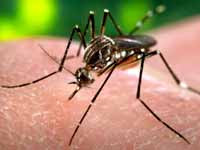World Lab-Verified Swine Flu A(H1N1) Infections
Country # Cases # Deaths
1. Brazil 16,668 / 1024
2. U.S. 44,522 / 667
3. Argentina 8,851 / 514
4. India 7,672 / 238
5. Mexico 25,214 / 218
6. Australia 36,210 / 172
7. Thailand 19,068 / 153
8. Peru 7,312 / 121
9. United Kingdom 13,471 / 79
10.Malaysia 7,066 / 77
11.Venezuela 1,316 / 72
12.Colombia 1,090 / 65
13.Ecuador 1,650 / 55
14.Paraguay 480 / 52
15.South Africa 11,253 / 47
+Saudi Arabia 4,119 / 28
Global Count: 339,458 CASES WITH 3,642 DEATHS
ONE out of every four people in Malaysia displaying influenza symptoms are suffering from the endemic (H1N1) 2009.
“If you see people having flu, fever or cough, there is a one in four chance they are H1N1 (positive),” says Health Minister Datuk Seri Liow Tiong Lai.
In fact, the World Health Organisation’s (WHO) projections are even grimmer – the virus could eventually infect two billion people or about a third of the world’s population.

Lab workers check chicken eggs that are being used to develop H1N1 flu vaccine at the Shanghai Institute of Biological Products in China
WHO spokesperson Aphaluck Bhatiasevi said in a statement that by the end of a pandemic, anywhere between 15% and 45% of a population would have been infected by the new pandemic virus. “Thirty per cent is a midpoint estimate and 30% of the world’s population is two billion,” she said.
Faced with such a grim scenario, vaccine manufacturers worldwide are doing their best to have their H1N1 vaccines ready as soon as possible. In fact, Sinovac Biotech Ltd, a China-based biopharmaceutical company, is the first in the world to have obtained a production licence for its H1N1 vaccine named PANFLU.1. It was expected to have delivered 3.3 million doses before Sept 15 for China’s needs.
Other companies worldwide have already started or completed clinical trials and are awaiting approval, and the vaccines should be shipped out by the end of the month.
However, with such a widespread pandemic, countries around the world are scrambling to obtain sufficient quantities of the vaccine, and in the initial stages of its release, stocks are going to be in very high demand.
A source says that Malaysia is not high on the list of countries that will be given the vaccine first. As most vaccines are manufactured in more developed countries, they will serve the local demand and the richer countries first “before they cater to our needs”, he adds. However, there are other countries lower on the “priority list” than Malaysia.
But Liow assures Malaysians that orders have been placed for 400,000 doses of the vaccine and we will be receiving the first 40,000 by the end of next month. The remaining 360,000 doses are expected to arrive in January next year. He says the vaccines are being sourced from GlaxoSmithKline (GSK) and will cost the government RM14mil.
The ministry will be selective when sourcing for the vaccines, Liow assures.
“Every country is grabbing the H1N1 vaccines and we have to place bookings early. But at the same time, we are looking for the best quality vaccines.
“We are trying to get as many sources as possible such as China and Taiwan, so in case of an emergency, we can get vaccines.”
He says Malaysia does not have production facilities for vaccines but is in the process of building one. “9bio has been directed to set up a vaccine-producing plant. This is a government-linked company set up under the Finance Ministry,” he adds.
With the vaccines in hand, the next important question is who would be vaccinated first. WHO has advised that healthcare workers should be the first in line and Malaysia will be following this guideline.
“Because there are limited stocks, we have to be very sure of the target group. We will be treating doctors and nurses first and also high-risk groups such as pregnant mothers,” Liow says.
Health Ministry Disease Control Division director Datuk Dr Hasan Abdul Rahman says that according to WHO experts, the priority of recipients depends on the local situation.
If the priority is to protect frontliners, then healthcare workers are vaccinated first, followed by essential services such as the police, he says. But if the purpose is to reduce deaths, then it should also be administered to high-risk groups such as pregnant women, those with chronic diseases and those below 24 years of age. But if further transmission is to be prevented, 85% of the population should be vaccinated.
One of the concerns about the vaccine is its safety as there have been instances in the past where a new vaccine caused unwanted side effects. A notable case involved a mass vaccination programme – also for a strain of the H1N1 virus – in the United States in 1976.
Not only did it result in deaths, it also increased the risk of developing Guillain-Barré syndrome. The programme was discontinued but only after approximately 48 million Americans or about 22% of the population had received the shots.
Dr Hasan puts such fears to rest, saying that the new vaccine is not exactly new, and the way it is produced is similar to that of seasonal influenza vaccines.
“Even though it is a new virus, it is still an influenza virus. They (pharmaceutical companies) have been producing seasonal vaccines every six months, so they have the technology and safety record. So it is not totally new but has some variations,” he says.
Nevertheless, before each vaccine can be used, it has to undergo clinical trials to ensure its safety. The results of the trials are then scrutinised by health authorities and once the findings are confirmed, the product will receive authorisation for general use.
Dr Hasan says Malaysia does not necessarily have to conduct clinical trials locally.
“Certain countries such as Australia, the US or those in the European Union have already done the studies. We can use the same information to register the vaccine in Malaysia.
“Our requirements and standards are the same, so if it is registered in the EU, for example, we can use it here as well. If we do this, we can save time – and that matters here,” he says.
He adds that most vaccines are undergoing clinical trials at the moment and are expected to fully comply with EU requirements by October.
In the case of any new vaccine, there is the possibility of side effects, he says.
“In this kind of situation, those taking the new vaccine will have to sign a consent form. However, you have to weigh which of the risks is bigger – the risk of complications from the disease or the risk of side effects from the medication. The majority of side effects are very mild, so if you ask me, I will take it,” says Dr Hasan.
Liow is warning of a second wave of H1N1 cases that may arise with the rainy season in the later part of the year – a situation that the WHO has warned everyone of as well.
The ministry is taking steps to reduce its effects or even prevent it from happening altogether, he says.
The first step is to increase surveillance so they will know if it is spreading at the community level to ensure early detection. Secondly, the number of treatment centres will be increased.
Liow says the Cabinet has recently approved a budget of RM158mil to increase the capacity of beds and upgrade ICU units in all hospitals.
Finally, he says, it is important that the awareness level of the people be high and they know the proper safeguards to prevent the spread of the disease – something which has been done since the start of the pandemic.
Dr Hasan says that a second wave of infections can occur if the virus is re-introduced and the people become complacent.
“The northern hemisphere is going into winter and traditionally, influenza activity increases then,” he says.
Another measure that Dr Hasan recommends is to take the seasonal influenza jab on top of the H1N1-specific vaccinations.
“If I am vaccinated against one or both, the likelihood of two different viruses infecting my body is low. Without it, a person may be infected by both viruses, and when they meet in the body, it can change into a new, mutated strain,” he says.
At the end of the day, personal hygiene is still one of the most effective ways to control the disease, says Dr Hasan.
“We have to continue to increase our commitment. All Malaysians are advised to remain vigilant and to take preventative measures. Take care of your personal hygiene, practise cough etiquette, see a doctor promptly and get the right antiviral medication,” Liow reiterates.
“It is important to repeat this piece of advice to ensure the people understand their respective responsibilities,” he says.




